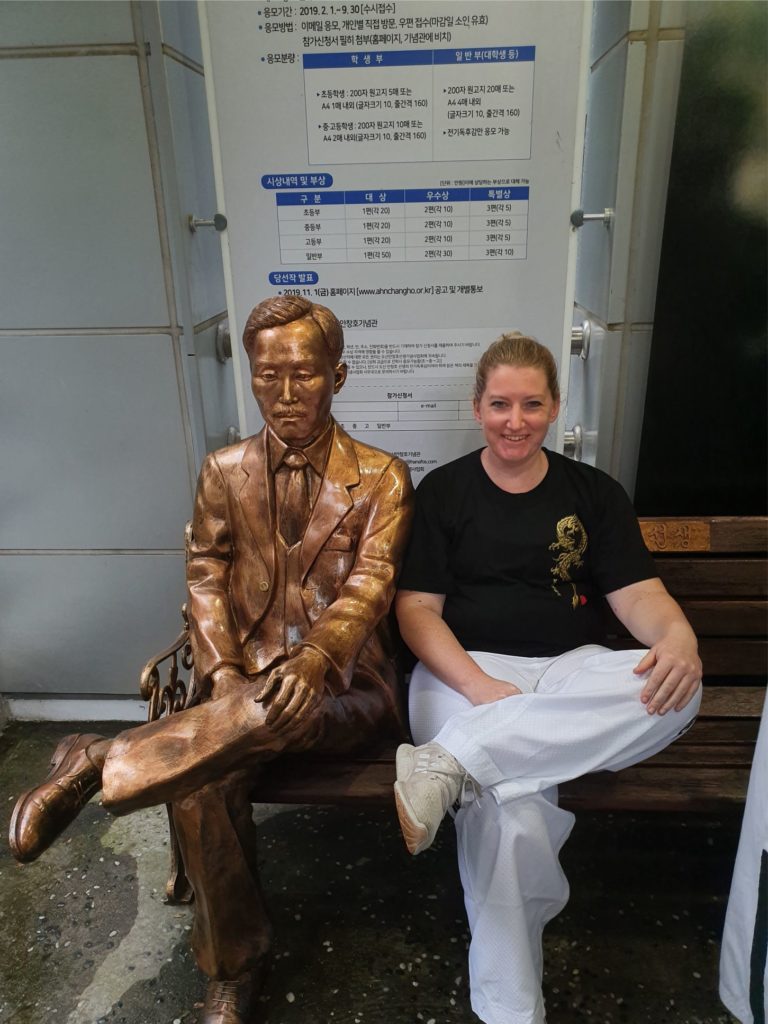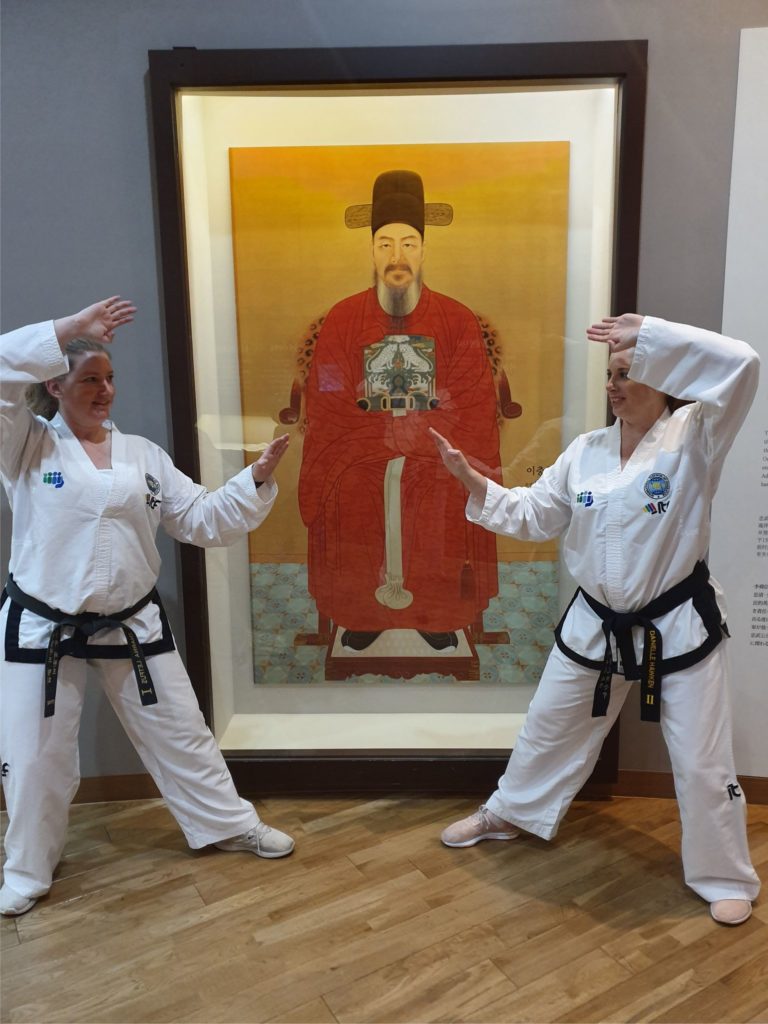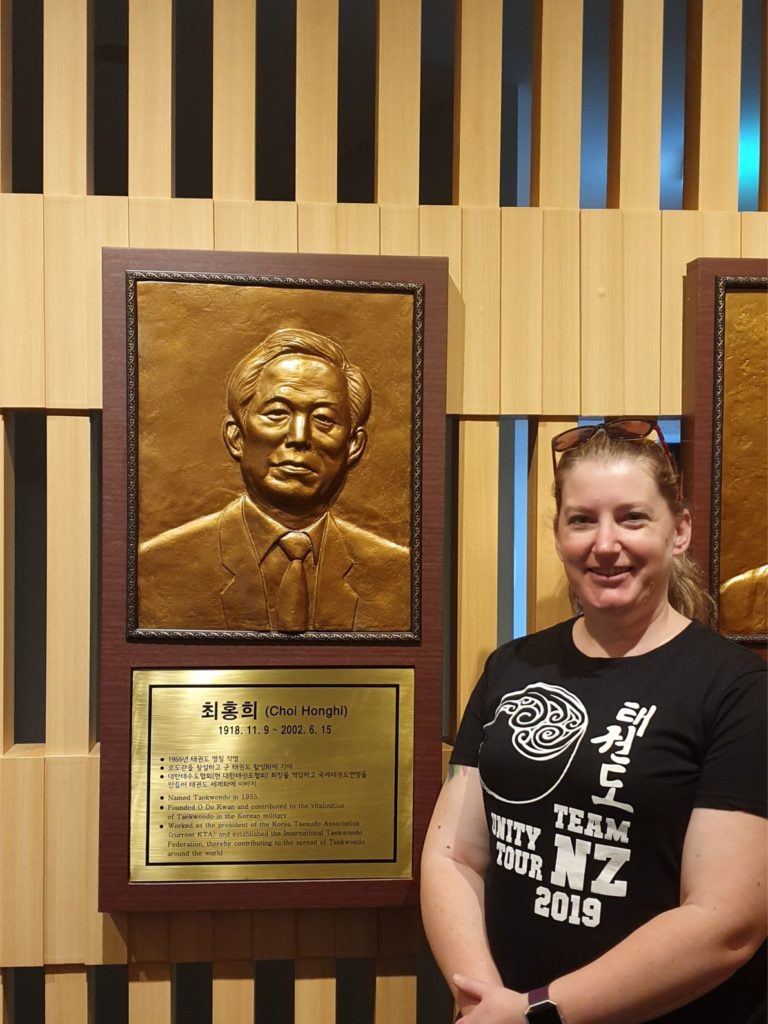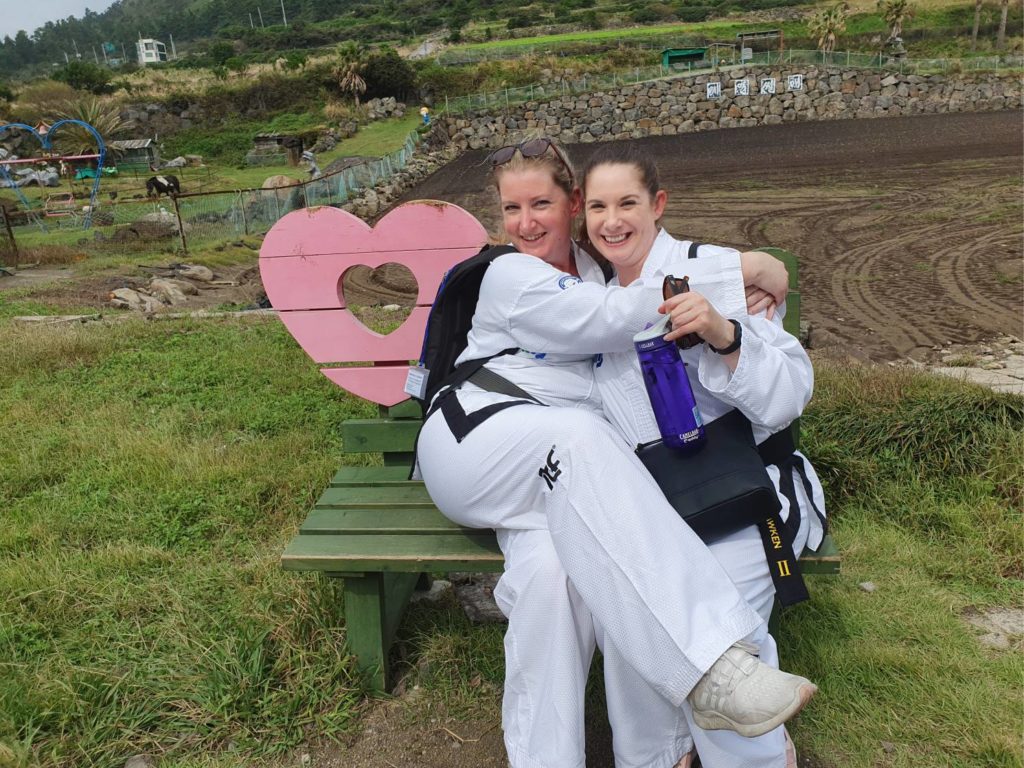This year I was given the opportunity to travel to South Korea, the home and birthplace of Gen Choi Hong Hi and Taekwon-Do. As a first degree struggling to find my feet again after a long break, I took the opportunity to be inspired and reignite my passion after more than a decade since my last grading.

On the 27th September a small contingent of black belts from my club flew out to South Korea to take part in a Tul Tour which was named the Unity Tour. Having a large NZ contingent this was named shortly after Christchurch attacks and referencing the coming together of many ITF practitioners that affiliate with different ITF organisations, but all brought together by our mutual love for our art.
We arrived in Seoul very early in the morning to an already hot and muggy day and a bunch of overtired jetlagged New Zealanders made their way to our Hotel to be told it was too early for check in. We left our luggage and went for coffee and out to see the sights. The War Memorial Museum was our first stop and the first look into some of the Korean History – the monuments dedicated to the countries that took part in their war were extensive and the displays very moving. The realistic model of the Kobukson was a favourite for our TKD mad crew and the models and artefacts relating to Kwang Gae, Gye Baek, Choong Moo and other famous Taekwon-Do names were very quickly discovered.
From there the group split and myself along with a few others visited a meerkat café and then went for “Chicken and Beer” a Korean favourite and had our first taste of Korean Soju. I could write a separate article on all the amazing food we had but there is so much to write I will leave out the food and hotel descriptions and stick to the sights and the Taekwon-Do.
We arrived back at the hotel once we could check in and met with our new Australian and Dutch friends before heading to bed to rise early the next day and meet Master Zibby Kruk at Gimpo airport and head to Jeju Island. Our first stop after arriving on Jeju was the Dragons Head Formation, this is a naturally formed volcanic structure that looks like a dragon’s head and body. This of course was very appealing to the Dragons Spirit crew and we took a tonne of photos.
Our first trip was to the “Fist” monument on Jeju Island that was originally erected by the 29th Infantry division when it was established by General Choi on Jeju Island. The use of General Choi’s fist on the division flag and emblem was symbolic of the Martial fighting spirit the General wanted to instil in his troops and was also used on this monument. This monument also contains the Calligraphy of Gen. Choi, labelling and teaching about that Martial Spirit. It was buried by the local people during the time that General Choi was out of favour with the President of Korea, but was rediscovered later, dug up and resurrected by a local businessman, Mr Kang. Jeju Island is known as the “Womb of Taekwon-Do”.
This was an amazing and inspirational start to our tour and we trained in the heat and humidity performing Hwa-Rang and some self defense basics.
From there we moved on to Sanbangsan Bomunsa Temple to see the rows and rows of buddhas and climbed the many temple stairs. The intricate carvings and gold work was an introduction to the beautiful Korean artistry we would see for the next 10 days. We made a trip to an old Dutch ship, the first to reach the shores of Korea then made our way along the Coast line where many many TKD poses and photos, and laughs ensued as we built on new friendships with our extended ITF family.
Then it was off to another stunning Buddhist temple where the carvings and statues are like nothing I have ever seen. Many more dragons and photos and some sightseeing before heading to Chonjiyeon Falls, where more photos were taken with the falls behind us. We practised Chon-Ji nearby before the rain came pouring down and typhoon warnings increased, and we returned to our hotel.
The next day we climbed Sunset Peak and took in the views before coming down and descending into the lava tubes of Jeju which are large underground tunnels formed by Lava flow years ago, It was colder under the ground and we enjoyed the relief from the humidity. We managed to find a cavern large enough to perform Po-Eun much to the delight of many tourists who stopped to video us and then our seniors took the time to practise Tong Il – the uneven floors proving to be a challenge on ankles and knees. It was a beautiful setting for some practise, and we took plenty of photos and video. The ongoing rain hampered some of our plans and we spent the evening exploring a local market and eating too much good food.
By day 4 the Typhoon was fast approaching preceded by the heavy rain. Regular emergency alerts were coming through on our phones and we doubted whether we would make it off the Island. We made the last flight off Jeju before they closed the airport. After making it to the mainland we made a brief stop at the beach where the ashes of Moon Moo were scattered for those who were determined to brave the rain. The more junior black belts huddled under umbrellas watching these mad seniors take TKD pics in the pouring rain. From there we made our way to Golgulsa temple, the resting place of Won Hyo. With the heavy rain the night before and that morning the steps and cliff face had become a waterfall but it made the site so much more magical. We climbed to the top to see the shrine where Won-Hyo spent his final hours. The view was breath taking and the realisation of being so close to the history and the feeling of Korean history and the people that Taekwon-Do history is built upon was a feeling like none other.
We were then able to train with the monks and watch a demonstration. These monks are beyond amazing and the movements and techniques they perform are spectacular. We ate a simple meal in the hall as their guests. When we left, the rain was coming down hard. The typhoon had come, and we were forced to cancel the planned visit to Anapchi, the training place of the Hwa-Rang – which only drives me to return at another time to see the places I missed out on.
I went to South Korea to be inspired and it was proving to be everything I hoped and more.
On day 5 we began our day with a trip to Bulguksa temple, here we performed Won-Hyo and took many more photos with the amazing backdrop of the temple, statues and gardens. They were preparing for a festival and the flowers and flags and prayer cards were everywhere. The Korean culture truly is beautiful.
Next up was a visit to a museum dedicated to the history of the Gyeonju regions, and especially the Silla Dynasty – also known as the Kingdom of Gold. The golden artefacts were gorgeous and again I hunted amongst the little English for TKD references – many writings referenced the Hwa-Rang and King Mun-Mu. and there was a large portrait of Won-Hyo.

From there we journeyed to Taekwondowon where we took part in a healing class. This was all about balance and body wellness and gave all of us a few ideas for our home dojangs. While one of our poor tour participants had his hips examined at great length throughout the exercise and the poor English of the master advising of how to watch for and see his “sick hips”.
The sheer size of Taekwondowon and the facilities of not only a permanent dojang but a full arena and accommodation for many. It was the size of a university complex and we all speculated on how amazing it would be to have something like this in NZ. We spent the night at Taekwondowon and in the morning we started with a visit to the Taekwon-Do museum. Although predominantly WTF Taekwon-Do we found the history of Taekwon-Do in Korea dating back to 2333 BC. Coincidentally or not the year of Dan-Gun, but also where bare-hand martial arts originated in Korea, and many more important dates for ITF Taekwon-Do highlighted on the timelines. When we found the portraits of important people in Taekwon-Do we all stopped to read about and take photos with the bronze portrait of the General Choi Hi.

At the end of the museum there Taekwondowon gift shop and many of us emptied our wallets on training equipment and TKD memorabilia.
We were then treated to a Taekwon-Do musical where the resident athletes danced and flipped and spun and broke hundreds of boards. It was well received by all members and an amazing end to our trip to Taekwondowon.
That afternoon we had a long bus trip to Asan where we all shared something of our journey in Taekwon-Do and the richness of life it had given to all of us. Although we came from different countries, backgrounds and different ITF groups it was amazing to hear of the shared impact on our lives and the importance of the art to all of us.
Asan was a beautiful place where we visited a museum dedicated to Admiral Yi Sun Shin where we were able to watch a movie about his life and battles and look at all of his writings and his history. It is easy to see why he is such an important person in Korean History. We made it to Asan on the right day as we were honoured to be part of a tea drinking ceremony held in Choong Moo’s own home. The gracefulness and tradition of the ceremony was beautiful, and it was a humbling experience to be in the place such a great man had lived. Choong Moo has always personally been my least favourite pattern. I left his home with a newfound appreciation and an better understanding of what this famous Admiral had done for Korea.
On day 7 we travelled to ITF HQ and took part instructing in an Amerikicks class and teach the Korean children some English through Taekwon-Do. These were the cutest little kids and were told a little more of what ITF HQ does in Korea and the English program they run for the children there. The lovely Sabina Kim who had been our gracious host and organiser for the entire trip played a traditional Korean instrument Kayagum with a group of beautifully dressed and talented women. This is also where we were presented with our Tul Tour Participation certificates.
From there we travelled to the Ahn Joong Gun museum. This was all in all one of the highlights of my trip. We watched a video on the history and walked through the exhibits. Including seeing the bloody handprints from when Ahn Joong Gun and his compatriots had cut off their ring fingers in a pledge to kill Hiro Bumi Ito.
Here I also discovered a connection between Joong Goon and Ahn Chang Ho (Do-San) as they were activists in the same time fighting for the same cause. We were able to practise Joong Gun under the large bronze statue outside the museum. The trips to these historical places were inspiring and eye opening. It is amazing how little we understand or appreciate what these men really did or stood for. The brief paragraph in our handbooks is nothing compared to the meaning of these men’s lives and achievements and I think very few who practise ITF Taekwon-Do truly understand the depth of history. This museum continued to really drive home the reason I wanted to come to Korea in the first place
On Day 8 we journeyed to Paju to the resting place of Yul-Gok. Here another connection was made between Yi-I and Yi-Hwang who were most prominent Korean Confucian scholars of the Joseon Dynasty and had met and written to one another. There was very little in English so we made out what little we could of the writings and artwork and saw many of the robes him and mother wore. We visited Yul Gok and his mother’s burial mounds and then returned down to the grounds to practice Yul-Gok together on his grounds.
We then went back to Seoul where 3 of our members left us to prepare for the guard changing ceremony at one of the great palaces. We wandered and found a place to learn to write our own names in Hang-Gul using calligraphy brushes and then walked to where the guard change ceremony was to take place and watched the ceremony. It was a stunning and colourful performance.
Our next stop was at a shrine of Dan-Gun where we took photos and trained and were gifted badges from the ladies looking after the shrine.
Later that evening we went to see a comedy show called “Jump”. This was a hilarious show with many different styles of martial arts, and they included the Audience much to our delight. One of our TKD group made their Korean theatre debut and the audience was well impressed with his ability to break roll and kick and strike with the performers. The rest of us were in stitches the whole time. A thoroughly good end to an amazing day
Our final day on the tour we started at the Do-San museum. Where I was reminded yet again how little we learn from our books. There was more English content here and we drank in the information. We then trained outdoors in the rain and performed a few amazing renditions of Do-San one handed with an umbrella in the other with his large statue watching on behind us.
We then returned to the War Memorial Museum but it was closed so we took advantage of the large sheltered spaces out the front to practice some black belt patterns until security came and moved us along.
We returned to Sejong and marvelled at the large statues of King Sejong and yet another of Admiral Yi Sun Sin then we spent the evening doing our final shopping and sight seeing at a local market.
One more night in the hotel and we caught the subway back to the airport and got on the flight home.
My trip to South Korea was a turning point in my training. I came back to NZ refreshed and inspired with a new appreciation for my art. I made some amazing friends and extended my Taekwon-Do family along the way. I would jump at the chance to go again and would recommend the trip to anyone looking for some inspiration or for a more indepth Taekwon-Do experience.

Zharna Welch, 1st Dan
Dragons Spirit Papatoetoe
